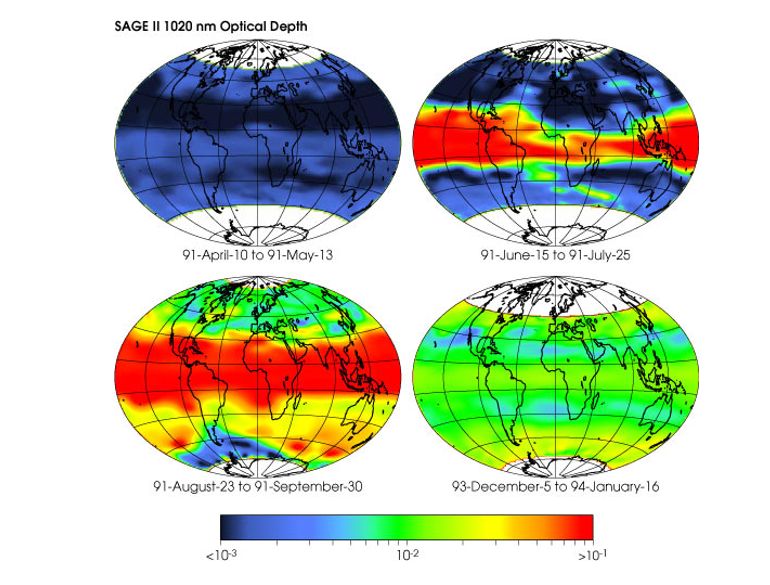55 Volcanic Hazards: Volcanic Gases, Pyroclastic Flow, and Tephra
Volcanic Gases and Their Effects
Magma contains dissolved gases that are released into the atmosphere during eruptions. Gases are also released from magma that either remains below ground (for example, as an intrusion) or is rising toward the surface. In such cases, gases may escape continuously into the atmosphere from the soil, volcanic vents, fumaroles, and hydrothermal systems.
At high pressures deep beneath the earth’s surface, volcanic gases are dissolved in molten rock. But as magma rises toward the surface where the pressure is lower, gases held in the melt begin to form tiny bubbles. The increasing volume taken up by gas bubbles makes the magma less dense than the surrounding rock, which may allow the magma to continue its upward journey. Closer to the surface, the bubbles increase in number and size so that the gas volume may exceed the melt volume in the magma, creating a magma foam. The rapidly expanding gas bubbles of the foam can lead to explosive eruptions in which the melt is fragmented into pieces of volcanic rock, known as tephra. If the molten rock is not fragmented by explosive activity, a lava flow will be generated.
Together with the tephra and entrained air, volcanic gases can rise tens of kilometers into Earth’s atmosphere during large explosive eruptions. Once airborne, the prevailing winds may blow the eruption cloud hundreds to thousands of kilometers from a volcano. The gases spread from an erupting vent primarily as acid aerosols (tiny acid droplets), compounds attached to tephra particles, and microscopic salt particles.
Volcanic gases undergo a tremendous increase in volume when magma rises to the Earth’s surface and erupts. For example, consider what happens if one cubic meter of 900°C rhyolite magma containing five percent by weight of dissolved water were suddenly brought from depth to the surface. The one cubic meter of magma now would occupy a volume of 670 m3 as a mixture of water vapor and magma at atmospheric pressure (Sparks et. al., 1997)! The one meter cube at depth would increase to 8.75 m on each side at the surface. Such enormous expansion of volcanic gases, primarily water, is the main driving force of explosive eruptions.
The most abundant gas typically released into the atmosphere from volcanic systems is water vapor (H2O), followed by carbon dioxide (CO2) and sulfur dioxide (SO2). Volcanoes also release smaller amounts of others gases, including hydrogen sulfide (H2S), hydrogen (H2), carbon monoxide (CO), hydrogen chloride (HCL), hydrogen fluoride (HF), and helium (He).
| Examples of volcanic gas compositions, in volume percent concentrations
(from Symonds et. al., 1994) |
|||
|---|---|---|---|
| Volcano
Tectonic Style Temperature |
Kilauea Summit
Hot Spot 1170°C |
Erta` Ale
Divergent Plate 1130°C |
Momotombo
Convergent Plate 820°C |
| H20 | 37.1 | 77.2 | 97.1 |
| C02 | 48.9 | 11.3 | 1.44 |
| S02 | 11.8 | 8.34 | 0.50 |
| H2 | 0.49 | 1.39 | 0.70 |
| CO | 1.51 | 0.44 | 0.01 |
| H2S | 0.04 | 0.68 | 0.23 |
| HCl | 0.08 | 0.42 | 2.89 |
| HF | — | — | 0.26 |
The volcanic gases that pose the greatest potential hazard to people, animals, agriculture, and property are sulfur dioxide, carbon dioxide, and hydrogen fluoride. Locally, sulfur dioxide gas can lead to acid rain and air pollution downwind from a volcano. Globally, large explosive eruptions that inject a tremendous volume of sulfur aerosols into the stratosphere can lead to lower surface temperatures and promote depletion of the Earth’s ozone layer. Because carbon dioxide gas is heavier than air, the gas may flow into in low-lying areas and collect in the soil. The concentration of carbon dioxide gas in these areas can be lethal to people, animals, and vegetation. A few historic eruptions have released sufficient fluorine-compounds to deform or kill animals that grazed on vegetation coated with volcanic ash; fluorine compounds tend to become concentrated on fine-grained ash particles, which can be ingested by animals.
Sulfur dioxide (SO2)
The effects of SO2 on people and the environment vary widely depending on (1) the amount of gas a volcano emits into the atmosphere; (2) whether the gas is injected into the troposphere or stratosphere; and (3) the regional or global wind and weather pattern that disperses the gas. Sulfur dioxide (SO2) is a colorless gas with a pungent odor that irritates skin and the tissues and mucous membranes of the eyes, nose, and throat. Sulfur dioxide chiefly affects upper respiratory tract and bronchi. The World Health Organization recommends a concentration of no greater than 0.5 ppm over 24 hours for maximum exposure. A concentration of 6-12 ppm can cause immediate irritation of the nose and throat; 20 ppm can cause eye irritation; 10,000 ppm will irritate moist skin within minutes.
Emission rates of SO2 from an active volcano range from <20 tonnes/day to >10 million tonnes/day according to the style of volcanic activity and type and volume of magma involved. For example, the large explosive eruption of Mount Pinatubo on 15 June 1991 expelled 3-5 km3 of dacite magma and injected about 20 million metric tons of SO2 into the stratosphere. The sulfur aerosols resulted in a 0.5-0.6°C cooling of the Earth’s surface in the Northern Hemisphere. The sulfate aerosols also accelerated chemical reactions that, together with the increased stratospheric chlorine levels from human-made chlorofluorocarbon (CFC) pollution, destroyed ozone and led to some of the lowest ozone levels ever observed in the atmosphere.
At Kilauea Volcano, the recent effusive eruption of about 0.0005 km3/day (500,000 m3) of basalt magma releases about 2,000 tonnes of SO2 into the lower troposphere. Downwind from the vent, acid rain and air pollution is a persistent health problem when the volcano is erupting.
- SO2 causes air pollution Volcanic smog. Eruptions of Kilauea Volcano release large quantities of sulfur dioxide gas into the atmosphere that can lead to volcanic air pollution on the Island of Hawai`i. Sulfur dioxide gas reacts chemically with sunlight, oxygen, dust particles, and water to form volcanic smog known as vog.
- SO2 effects Earth’s surface temperature Global cooling and ozone depletion. Measurements from recent eruptions such as Mount St. Helens, Washington (1980), El Chichon, Mexico (1982), and Mount Pinatubo, Philippines (1991), clearly show the importance of sulfur aerosols in modifying climate, warming the stratosphere, and cooling the troposphere. Research has also shown that the liquid drops of sulfuric acid promote the destruction of the Earth’s ozone layer.
Mt. Pinatubo eruption June 12 – 16, 1991
Hydrogen sulfide (H2S)
Hydrogen sulfide (H2S) is a colorless, flammable gas with a strong offensive odor. It is sometimes referred to as sewer gas. At low concentrations it can irritate the eyes and acts as a depressant; at high concentrations it can cause irritation of the upper respiratory tract and, during long exposure, pulmonary edema. A 30-minute exposure to 500 ppm results in headache, dizziness, excitement, staggering gait, and diarrhea, followed sometimes by bronchitis or bronchopneumonia.
Carbon dioxide (CO2)
Volcanoes release more than 130 million tonnes of CO2 into the atmosphere every year. This colorless, odorless gas usually does not pose a direct hazard to life because it typically becomes diluted to low concentrations very quickly whether it is released continuously from the ground or during episodic eruptions. But in certain circumstances, CO2 may become concentrated at levels lethal to people and animals. Carbon dioxide gas is heavier than air and the gas can flow into in low-lying areas; breathing air with more than 30% CO2 can quickly induce unconsciousness and cause death. In volcanic or other areas where CO2 emissions occur, it is important to avoid small depressions and low areas that might be CO2 traps. The boundary between air and lethal gas can be extremely sharp; even a single step upslope may be adequate to escape death.
CO2 trapped in depressions can be lethal to people and animals. When a burning piece of cloth is lowered into a hole that has a high concentration of CO2, the fire goes out. Such a condition can be lethal to people and animals.
Air with 5% CO2 causes perceptible increased respiration; 6-10% results in shortness of breath, headaches, dizziness, sweating, and general restlessness; 10-15% causes impaired coordination and abrupt muscle contractions; 20-30% causes loss of consciousness and convulsions; over 30% can cause death (Hathaway et. al., 1991).
Please see the web article, “Volcanic Gases and Climate Change Overview” for more information on Volcanic versus anthropogenic CO2emissions.
Here is a historical example of the effects of carbon dioxide gas: Mammoth Mountain in Long Valley Caldera, California kills trees near Mammoth Mountain, California
Hydrogen Chloride (HCl)
Chlorine gas is emitted from volcanoes in the form of hydrochloric acid (HCl). Exposure to the gas irritates mucous membranes of the eyes and respiratory tract. Concentrations over 35 ppm cause irritation of the throat after short exposure; >100 ppm results in pulmonary edema, and often laryngeal spasm. It also causes acid rain downwind from volcanoes because HCl is extremely soluble in condensing water droplets and it is a very “strong acid” (it dissociates extensively to give H+ ions in the droplets).
Hydrogen Fluoride (HF)
Fluorine is a pale yellow gas that attaches to fine ash particles, coats grass, and pollutes streams and lakes. Exposure to this powerful caustic irritant can cause conjunctivitis, skin irritation, bone degeneration and mottling of teeth. Excess fluorine results in a significant cause of death and injury in livestock during ash eruptions. Even in areas that receive just a millimeter of ash, poisoning can occur where the fluorine content of dried grass exceeds 250 ppm. Animals that eat grass coated with fluorine-tainted ash are poisoned. Small amounts of fluorine can be beneficial, but excess fluorine causes fluorosis, an affliction that eventually kills animals by destroying their bones. It also promotes acid rain effects downwind of volcanoes, like HCl.
Pyroclastic Flows and Their Effects
About Pyroclastic Flows
Pyroclastic flows are high-density mixtures of hot, dry rock fragments and hot gases that move away from the vent that erupted them at high speeds. They may result from the explosive eruption of molten or solid rock fragments, or both. They may also result from the nonexplosive eruption of lava when parts of dome or a thick lava flow collapses down a steep slope. Most pyroclastic flows consist of two parts: a basal flow of coarse fragments that moves along the ground, and a turbulent cloud of ash that rises above the basal flow. Ash may fall from this cloud over a wide area downwind from the pyroclastic flow.
Figure 1 shows a remnant of a building in Francisco Leon that was destroyed by pyroclastic flows and surges during the eruption of El Chichon volcano in southeastern Mexico between March 29 and April 4, 1982. Francisco Leon was located about 5 km SSE of the volcano. The reinforcement rods in the concrete wall are bent in the direction of flow (right to left).

Figure 1. Pyroclastic Flows destroy by direct impact
Several pyroclastic surges swept down all sides of the volcano, reaching as far as 2 to 8 km from the volcano; pyroclastic flows represent only about 30 percent of the total combined mass of surges and flows. In addition to Francisco Leon, eight other villages were destroyed, claiming the lives of up to 2,000 people.
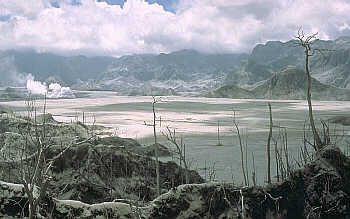 Figure 2. Pyroclastic Flows bury sites with hot rock debris.
Figure 2. Pyroclastic Flows bury sites with hot rock debris.
A series of pyroclastic flows from Redoubt Volcano in Alaska between December 1989 and April 1990 rapidly melted snow and ice that generated lahars in Drift River (valley in figure 3).
 Figure 3. Pyroclastic Flows melt snow and ice to form lahars.
Figure 3. Pyroclastic Flows melt snow and ice to form lahars.
This view across the upper Drift River valley is to the SW; the north flank is on the right side of the volcano, but the dome is not visible. As each pyroclastic flow swept down the volcano’s snow- and glacier-covered north flank, the hot lava-dome fragments eroded and mixed with the snow and ice to form a torrent of water that swept into Drift River. The sudden surges of water eroded loose sediment on the valley floor and transformed into lahars.
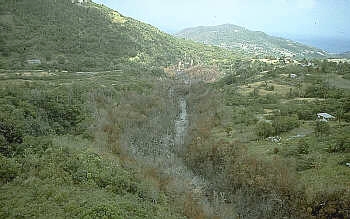 Figure 4. Pyroclastic Flows burn forests, crops, and buildings.
Figure 4. Pyroclastic Flows burn forests, crops, and buildings.
The basal part of the pyroclastic flow was confined to the channel bottom, but the overriding hot ash cloud burned and killed vegetation along the channel. The pyroclastic flow was triggered by a partial collapse of the dome. With initial temperatures higher than 900°C, the rock debris and gas carried by a pyroclastic flow or surge easily remain hot enough to burn or singe combustible material even when they travel more than 20 km from a vent.
Effects of Pyroclastic Flows
A pyroclastic flow will destroy nearly everything in its path. With rock fragments ranging in size from ash to boulders traveling across the ground at speeds typically greater than 80 km per hour, pyroclastic flows knock down, shatter, bury or carry away nearly all objects and structures in their way. The extreme temperatures of rocks and gas inside pyroclastic flows, generally between 200°C and 700°C, can cause combustible material to burn, especially petroleum products, wood, vegetation, and houses.
Pyroclastic flows vary considerably in size and speed, but even relatively small flows that move less than 5 km from a volcano can destroy buildings, forests, and farmland. And on the margins of pyroclastic flows, death and serious injury to people and animals may result from burns and inhalation of hot ash and gases.
Pyroclastic flows generally follow valleys or other low-lying areas and, depending on the volume of rock debris carried by the flow, they can deposit layers of loose rock fragments to depths ranging from less than one meter to more than 200 m. Such loose layers of ash and volcanic rock debris in valleys and on hillslopes can lead to lahars indirectly by:
- Damming or blocking tributary streams, which may cause water to form a lake behind the blockage, overtop and erode the blockage, and mix with the rock fragments as it rushes downstream (for example, see this case study at Pinatubo Volcano, Philippines)
- Increasing the rate of stream runoff and erosion during subsequent rainstorms. Hot pyroclastic flows and surges can also directly generate lahars by eroding and mixing with snow and ice on a volcano’s flanks, thereby sending a sudden torrent of water surging down adjacent valleys (see case study from Nevado del Ruiz volcano, Colombia).
Tephra and Their Effects
Tephra is a general term for fragments of volcanic rock and lava regardless of size that are blasted into the air by explosions or carried upward by hot gases in eruption columns or lava fountains. Such fragments range in size from less than 2 mm (ash) to more than 1 m in diameter. Large-sized tephra typically falls back to the ground on or close to the volcano and progressively smaller fragments are carried away from the vent by wind. Volcanic ash, the smallest tephra fragments, can travel hundreds to thousands of kilometers downwind from a volcano.
Tephra consists of a wide range of rock particles (size, shape, density, and chemical composition), including combinations of pumice, glass shards, crystals from different types of minerals, and shattered rocks of all types (igneous, sedimentary, and metamorphic). A great variety of terms are used to describe the range of rock fragments thrown into the air by volcanoes. The terms classify the fragments according to size, shape, or the way in which they form and travel.
| Mount St. Helens Tephra: block | Mount St. Helens Tephra: ash & pumice | Kilauea Tephra: reticulite | Kilauea Tephra: Pele’s hair |
 |
<img class="alignnone wp-image-727 size-full" src="https://s3-us-west-2.amazonaws.com/courses-images-archive-read-only/wp-content/uploads/sites/459/2015/06/21062246/30410914_075_med.jpg" alt="A sample of tephra erupted by Mount St. Helens on May 18, 1980. The tephra was collected between about 40 and 60 km downwind from the volcano. Most of the tephra consists of pumice. The largest fragment is about 5 mm in diameter. Tephra between 2 and 64 mm in diameter is called lapilli; tephra | 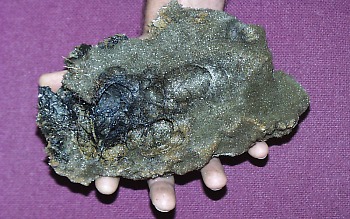 |
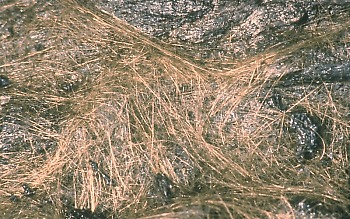 |
Volcanic Ash
How far will it fall downwind from an erupting volcano?
Ash usually covers a much larger area and disrupts the lives of far more people than the other more lethal types of volcano hazards. Unfortunately, the size of ash particles that fall to the ground and the thickness of ashfall downwind from an erupting volcano are difficult to predict in advance. Not only is there a wide range in the size of an eruption that might occur and the amount of tephra injected into the atmosphere, but the direction and strength of the prevailing wind can vary widely.
Case Histories: Tephra Distribution Downwind from Eruption
- Tephra Falls of the 1991 Eruptions of Mount Pinatubo online report from Fire and Mud: eruptions and lahars of Mount Pinatubo, Philippines.
- Tephra fall from Mount St. Helens, Washington, on May 18, 1980 graph, ash thickness and particle size downwind from volcano
Potential Effects of Volcanic Ash
Volcanic ash is highly disruptive to economic activity because it covers just about everything, infiltrates most openings, and is highly abrasive. Airborne ash can obscure sunlight to cause temporary darkness and reduce visibility to zero. Ash is slippery, especially when wet; roads, highways, and airport runways may become impassable. Automobile and jet engines may stall from ash-clogged air filters and moving parts can be damaged from abrasion, including bearings, brakes, and transmissions.
More effects include the following:
- Daylight turns into darkness.
- Roofs may collapse from added weight.
- Machinery and vehicles will be abraded.
- Farmland will be covered.
- Roads will be slippery, blocked, or blocked.
- Power systems may shut down.
- Waste-water systems may clog.
- Gutters may fill and collapse.
Signs of an Eruption
- Gas leaks — the release of gases (mostly H2O, CO2, and SO2) from the magma into the atmosphere through cracks in the overlying rock
- Bit of a bulge — the deformation of part of the volcano, indicating that a magma chamber at depth is swelling or becoming more pressurized
- Getting shaky — many (hundreds to thousands) of small earthquakes, indicating that magma is on the move. The quakes may be the result of the magma forcing the surrounding rocks to crack, or a harmonic vibration that is evidence of magmatic fluids moving underground.
- Dropping fast — a sudden decrease in the rate of seismicity, which may indicate that magma has stalled, which could mean that something is about to give way
- Big bump — a pronounced bulge on the side of the volcano (like the one at Mt. St. Helens in 1980), which may indicate that magma has moved close to surface
- Blowing off steam — steam eruptions (a.k.a. phreatic eruptions) that happen when magma near the surface heats groundwater to the boiling point. The water eventually explodes, sending fragments of the overlying rock far into the air.
